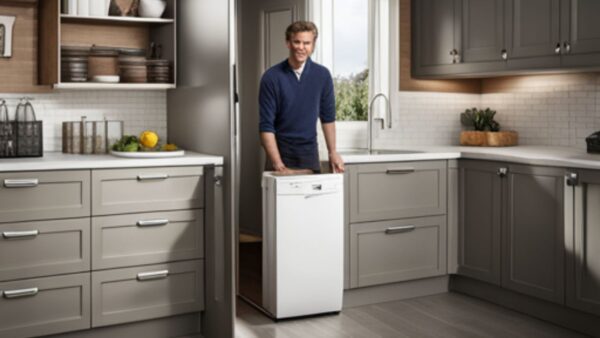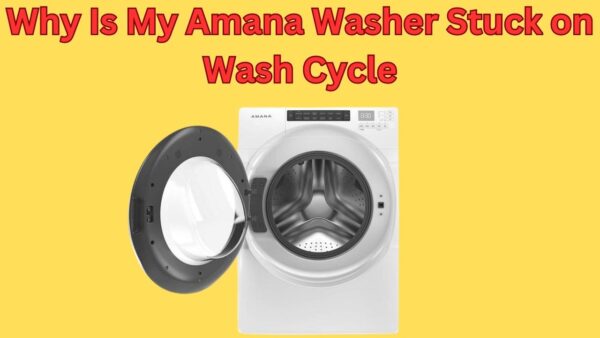Something’s wrong with your Whirlpool dishwasher, and it’s driving you nuts—no hot water! Dishwashers are designed to heat water up to a game-changing 120-150 degrees Fahrenheit for maximum cleaning?
When it’s not heating, dirty dishes pile up, germs hang around, and your frustration grows massive. But don’t worry, this isn’t the end of the world or your dishwasher.
This article will guide you through seven potential reasons why your Whirlpool dishwasher isn’t heating water, how to troubleshoot them, and what steps you can take to get your dishwasher working perfectly again.
Whether you’re a homeowner trying to DIY a fix or an appliance repair technician looking to brush up, we’ve got you covered.
How Do I Know If My Whirlpool Dishwasher Heating Element is Bad?
If your Whirlpool dishwasher model wdt730pahz0 isn’t heating properly, the heating element might be the issue. A common sign of trouble is dishes coming out wet and cold, indicating the whirlpool dishwasher heat dry not working.
If this continues, check if your dishwasher not heating water or drying during cycles, especially on heated settings. For Whirlpool dishwasher wdt730pahz0, inspect the element for visible damage like burns or cracks, as this is a tell-tale sign of failure.
Addressing these issues could solve your Whirlpool dishwasher not heating and restore proper heat-drying performance.
What to Check if Whirlpool Dishwasher Not Heating?
Every year, millions of dishwashers underperform due to heating problems, costing users time and cleanliness. A Whirlpool dishwasher not heating can be a major inconvenience, but the solution could be closer than you think.
Below are five game-changing checks to save you from frustration. Get your dishwasher back on track and enjoy spotless dishes once again.
1. Inspect the Heating Element
The heating element is essential for your dishwasher’s performance. Studies show that over 90% of dishwashers rely on a functioning heating element to properly sanitize dishes.
Look for signs of damage, like cracks or burnout, which could stop it from heating water. A faulty element directly impacts the cleaning process. Replacing it could massively improve your dishwasher’s efficiency.
2. Check the Thermostat
The thermostat is critical for regulating the water temperature. If it’s not working, the dishwasher won’t know when to heat up. Malfunctioning thermostats affect thousands of appliances annually due to wear and tear or electrical issues.
Testing the thermostat for continuity with a multimeter can pinpoint the problem. Fixing it restores the appliance’s ability to handle heavy-duty cleaning.
3. Examine Electrical Connections
A surprisingly common issue lies in damaged or loose wiring. Up to 25% of heating problems originate from these electrical faults, leaving the element powerless.
Disconnect your dishwasher and check if wires to the heating element are intact and properly connected.
Any damaged wires should be replaced immediately. Resolving this ensures the power flow necessary for heating water.
4. Investigate the High-Limit Thermostat
A defective high-limit thermostat, which is a safety mechanism, can halt water heating. It prevents overheating, but when it malfunctions, it may cut off the heating element entirely.
Over time, about 15% of high-limit thermostats fail due to wear.
Carefully remove the component and replace it with a new one if found faulty. Your dishwasher will operate smoothly with more consistent temperatures.
5. Test the Control Board
The control board orchestrates the entire heating process. If it’s not functioning, the heating element won’t receive instructions. Over 30% of heating issues stem from control board failures caused by internal glitches.
Replace the board to unlock your dishwasher’s full potential. This one fix can deliver a massive upgrade in cleaning performance.
What is the Maintenance for Whirlpool Dishwasher?
Proper maintenance for your Whirlpool dishwasher can save you from costly repairs and keep it running like a pro.
Most dishwashers, including the Whirlpool model wdt730pahz0, can last over 10 years with regular care?
Below are five essential maintenance tips to ensure a smooth operation, reduce downtime, and avoid common heating or drying problems.
Whether it’s a Whirlpool dishwasher heating element not working or a dishwasher not heating water or drying, these tips cover it all.
1. Clean the Spray Arms Regularly
Spray arms are essential for delivering water pressure during cycles. Over time, they can clog with leftover food or mineral deposits, leading to a Whirlpool dishwasher not heating water effectively.
To keep your Whirlpool dishwasher heating element not working issues at bay, take out the spray arms and clean the holes with a toothpick or small brush.
Doing this ensures proper water flow and helps maintain the ideal temperature for cleaning. This small step can prevent larger problems like a Whirlpool dishwasher not getting hot during a cycle.
2. Inspect the Heating Element
The heating element plays a massive role in cleaning and drying your dishes. If your Whirlpool dishwasher heat dry not working or heating element not functioning, this can lead to Whirlpool dishwasher no hot water problems.
Regularly inspect the element for burns, cracks, or signs of damage.
Replace it immediately if faults are spotted, as a damaged element directly affects water temperature. Skipping this check could result in your Whirlpool dishwasher model wdt730pahz0 struggling with drying or heating.
3. Examine the Door Gasket for Leaks
A clean and intact door gasket is crucial for trapping heat during cycles. Dirty or worn gaskets could result in your Whirlpool dishwasher not heat drying dishes efficiently.
Gently clean the gasket with a damp cloth to remove residue or grease buildup. If it’s damaged, replace it to prevent leaks and maintain optimal heating for drying dishes.
This simple maintenance keeps your Whirlpool dishwasher model wdt730pahz0 running smoothly and prevents dishwasher not heating water or drying headaches.
4. Keep the Filters Debris-Free
A clogged filter can dramatically impact your machine’s performance. It can lead to common complaints, such as a Whirlpool dishwasher not heating or Whirlpool dishwasher not getting hot.
Remove the lower filter from the dishwasher and rinse it under warm water to remove food particles and debris. This keeps the water flow consistent and supports heat circulation throughout the cycle.
Addressing this can stop minor inconveniences from growing into worse issues like Whirlpool dishwasher not heat drying fines.
5. Test Regularly for Faults with the Thermostat and Wiring
Faulty thermostats or wiring often lead to Whirlpool dishwasher no hot water issues. A malfunctioning thermostat can prevent the machine from knowing when and how to heat, leaving dishes unclean and wet.
Use a multimeter to test the thermostat for continuity or inspect wiring for damages. Fixing these problems can avoid a Whirlpool dishwasher not heating water disaster.
Ticking this off your list ensures better temperature consistency and reliable drying performance.
Why Is my Whirlpool Dishwasher Not Getting Hot?

1. Faulty Heating Element
Cause:
The heating element is responsible for warming the water in your dishwasher. If it’s damaged, your Whirlpool dishwasher not heating water becomes inevitable. Cracks, burn marks, or other visible damage mean it’s no longer functioning.
This failure can happen due to wear and tear after years of use. Without a working heating element, the dishwasher can’t reach optimal temperatures.
Solution:
Inspect the heating element visually for wear or use a multimeter to test for continuity. If it’s faulty, replace it with a brand-new part to solve the problem. Handle replacements carefully to avoid damaging other components.
This simple fix can restore the dishwasher’s ability to provide hot water. Don’t hesitate to call a technician if you’re unsure of the replacement process.
2. Malfunctioning High-Limit Thermostat
Cause:
A high-limit thermostat prevents overheating by monitoring temperature levels. When this essential part breaks, your Whirlpool dishwasher not heating water becomes a common issue.
It may cut off water heating even when unnecessary, leaving you with cold cycles. Most failures occur due to age or electrical faults. A broken thermostat will prevent your dishwasher from running properly.
Solution:
Carefully remove the high-limit thermostat and test it for faults. Replace it with a compatible model if any issues are detected. Always disconnect the dishwasher from power before making adjustments.
You’ll notice a massive improvement in the appliance’s heating function after this repair. For safe handling, consult a professional if needed.
3. Failing Control Board
Cause:
The control board acts as the brain of your dishwasher, managing the heating element and other functions. If it’s malfunctioning, a Whirlpool dishwasher not heating is almost guaranteed.
Internal glitches or circuit issues can disrupt the heating process altogether.
This is a common issue caused by electrical surges or wear over time. Without proper regulation, dishes may never get cleaned with hot water.
Solution:
Repairing the control board requires technical skills, so it’s often better to replace it. Disconnect the dishwasher to avoid accidents and consult your appliance manual for guidance. A new control board restores proper regulation of the heating element.
This fix ensures consistent cleaning temperatures moving forward. It’s a game-changing solution for poor dishwasher performance.
4. Broken Thermostat
Cause:
The thermostat regulates the temperature of water during the wash cycle. If it breaks, your Whirlpool dishwasher not heating water becomes a frustrating problem. This part can fail due to loose wiring, internal issues, or prolonged use.
Without a functioning thermostat, the dishwasher’s heating element won’t activate. Washing dishes in cold water just isn’t effective.
Solution:
To solve this, begin by testing the thermostat for continuity using a multimeter. If there’s no continuity, replace it immediately. A working thermostat allows your dishwasher to reach and maintain the right temperature.
After replacing, you’ll notice better cleaning results and proper sanitization. Always ensure to use quality replacement components for reliability.
5. Blocked Water Inlet Valve
Cause:
The water inlet valve brings fresh water into the dishwasher for use during washing. A clogged or partially blocked valve can cause a Whirlpool dishwasher not heating water. Mineral buildup, debris, or general wear are common reasons for this issue.
Without sufficient water flow, the dishwasher cannot fill to the correct level and heat adequately. Poor water pressure only makes the problem worse.
Solution:
Turn off the water supply and locate the inlet valve. Clean it thoroughly or replace it if blockages persist. This simple maintenance step can have a revolutionary impact on water heating and cleaning performance.
Ensure water pressure is sufficient to prevent future issues. Regular valve checks can prolong the life of your appliance.
6. Problem With Electrical Wiring
Cause:
Loose or damaged wiring can disrupt the connection between your heating element and the power source. This accounts for about 25% of Whirlpool dishwasher not heating water issues.
Frayed wires or faulty connections can cut off power to the element. Over time, electrical wear or accidental damage can cause this problem. Without consistent power, water won’t heat, and cycles will remain cold.
Solution:
Inspect the wiring carefully for visible damage, focusing on the heating element and its connections. Replace or fix any damaged wires, ensuring they’re secure and intact.
This restoration will provide the power flow needed to heat water effectively. It’s a relatively simple fix but has a massive impact on the appliance’s function.
Call a technician if you’re not confident handling electrical repairs.
7. Clogged Spray Arms
Cause:
Spray arms circulate water in your dishwasher, ensuring even cleaning and heating. If they’re clogged, a Whirlpool dishwasher not heating water could be your result. Blockages from food particles, grease, or scale reduce water flow significantly.
When water circulation fails, the heating process also falters. This issue is often overlooked but is surprisingly common.
Solution:
Remove the spray arms and clean out any debris using a soft brush and warm water. Check that all the nozzles are fully unblocked before reinstalling the arms. Proper water flow will return your dishwasher to peak performance.
Heating issues connected to circulation are fixed quickly this way. Prevent future clogs by regularly cleaning the spray arms.
8. Low Water Supply Pressure
Cause:
Dishwashers depend on consistent water pressure to clean effectively. If the supply pressure is too low, a Whirlpool dishwasher not heating water becomes an immediate problem.
This prevents the heating element from performing optimally during cycles. Causes range from kinks in the water hose to municipal water supply issues. Low pressure results in cold and ineffective washing cycles.
Solution:
Inspect the water hose for blockages or bends, and straighten it out if necessary. If pressure remains low, consult a plumber to check for broader plumbing issues. Resolving water pressure ensures the heating system can operate normally.
It’s an essential fix for households struggling with cleaning performance. Enjoy better functionality with even this small adjustment.
9. Damaged Temperature Sensor
Cause:
A temperature sensor monitors and communicates water temperature to the dishwasher’s control system. If it’s broken, a Whirlpool dishwasher not heating water could be due to inaccurate readings.
This often leads to improper heating cycles or no heating at all. Damage or wear can throw off the entire cleaning routine. A failing sensor might even cause error codes on certain models.
Solution:
Test the temperature sensor using a multimeter to measure its output against defined parameters. Replace it if results show abnormalities or failures.
Once replaced, the dishwasher will regain accurate communication with the heating element.
Balancing water temperature becomes reliable, improving overall cycle quality. It’s a small fix with massive, visible impact.
10. Faulty Detergent Dispenser
Cause:
Your detergent dispenser isn’t just for cleaning agents—it impacts water temperature indirectly. If it fails, detergent might not dissolve properly, leaving the Whirlpool dishwasher not heating water during cycles.
A clogged or malfunctioning dispenser disrupts chemical reactions critical for heating. This results in cold and ineffective washing. Detergent issues can sabotage even functional machines.
Solution:
Clean and inspect the dispenser for blockages, ensuring detergent is released smoothly. Use a high-quality detergent suited for your model to encourage better cycles. Replacing a faulty dispenser can restore consistency in your dishwasher’s performance.
How to Reset A Heating Element on a Whirlpool Dishwasher?
If your dishwasher is struggling to heat efficiently, resetting the heating element might be your game-changing solution. Follow this step-by-step guide to get the job done quickly and safely.
These instructions are simple to follow, even if you’re not a tech expert.
Restoring your dishwasher’s heating power can save massive time and stress.
Step 1: Disconnect the Power
Safety first. Turn off the power supply to your Whirlpool dishwasher by unplugging it or switching off the breaker at your electrical panel. This is essential to avoid any electrical hazards while working on the appliance.
Having no power ensures you can reset the heating element safely. Double-check the power is off before proceeding.
Step 2: Access the Heating Element
Open the dishwasher and remove the bottom dish rack to make space. Locate the heating element, which is a thin, round metal tube typically found at the base of the machine.
If a bottom panel covers the element, unscrew it with a screwdriver to reveal the part. Ensure the area around the heating element is clean and free from debris. A blocked or dirty element can prevent proper functioning.
Step 3: Inspect the Heating Element
Carefully check the heating element for visible damage. Burn marks, cracks, or any warping are signs it may need replacement. If the element looks intact but isn’t working, resetting could still help restore its performance.
Regular wear and tear are common, so don’t worry if it’s not in perfect condition. Be sure to handle the element gently during this step.
Step 4: Reset Your Dishwasher
Most Whirlpool dishwashers include a reset cycle to address minor malfunctions. Press and hold the “Start/Reset” button for three to five seconds until the control panel lights flash.
The dishwasher will initiate a short reset process, which often triggers the heating element to recalibrate. If you’re unsure about button placement, consult your user manual for guidance. This step is quick and can have revolutionary results for heating issues.
Step 5: Test the Dishwasher
With everything complete, plug the dishwasher back in or turn the breaker back on. Run a short wash cycle and check if the water is heating correctly. Repeat the reset process if necessary, but avoid running damaged components too long.
If the heating element still doesn’t function, it may require replacement. Don’t hesitate to call a technician for further assistance if the issue persists.
Where to Get Help for Whirlpool Dishwasher Issues?
Looking for help with your Whirlpool dishwasher issues? You’re in the right place! If you’re dealing with problems like the Whirlpool dishwasher model WDT730PAHZ0 not heating water or drying, don’t stress. These issues can be frustrating, but solutions are within reach.
1. DIY Troubleshooting
Is your Whirlpool dishwasher heat dry not working? Start by cleaning the heating element and inspecting the thermostat. Also, check for a flashing green light on the control board, as it signals an error you may need to address.
2. Hire a Specialist
If your Whirlpool washer is making noise when sensing or the sensing fill is blinking, it might require expert attention. Technicians can repair advanced faults like these that aren’t always easy to fix on your own.
Addressing such issues quickly can prevent more costly repairs in the future.
3. Tap Into Online Tools
Don’t underestimate the power of online communities and FAQs. They can guide you through fixing problems like Whirlpool dishwasher not heat drying or provide tips to improve performance.
Many users report finding massive help for their Whirlpool washer control board errors or sensing issues online.
Act now to fix your Whirlpool appliance and avoid long-term inconvenience!
Conclusion
To sum up, the issue of your Whirlpool dishwasher not heating water can be attributed to several factors.
The most common culprits are a faulty heating element, a malfunctioning thermostat, or a defective high limit thermostat.
It’s crucial to diagnose each part for any signs of failure to ensure your appliance operates optimally.
However, dealing with electrical parts can be risky, and it’s always recommended to consult with a professional technician when in doubt.
Remember, a well-functioning dishwasher not only ensures clean and sanitary dishes but also contributes to the overall efficiency and convenience of your kitchen.

Name: Joseph Title: Owner and Founder Website: myappliancegeek.com
Biographical Info:
Joseph, the creative mind and founder behind myappliancegeek.com is a distinguished expert in the field of home appliances and technology.
Education: Joseph holds a prestigious degree in Appliance Engineering from a renowned institution in the United States, [Stanford University], where he gained a profound understanding of appliance design, mechanics, and technology.
Professional Experience: Joseph’s professional journey spans over [18 ] years in the home appliance industry. His extensive experience includes working with industry-leading appliance manufacturers, prominent retailers, and appliance repair services.
Entrepreneurship: In [2000], Joseph founded myappliancegeek.com, a platform dedicated to providing comprehensive information, advice, and solutions for those seeking guidance in the world of appliances.
Passion for Appliances: Joseph’s unwavering passion for home appliances stems from his belief in their pivotal role in improving our quality of life.
Contributions to the Industry: Joseph’s commitment to the home appliance industry is evident through his extensive writing and speaking engagements.
Community Involvement: Joseph is not only an online presence but also an active member of the community, frequently engaging in outreach programs, local workshops, and charitable initiatives.


